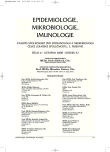-
Medical journals
- Career
Characterization and Prevalence of Clones of Listeria monocytogenes Isolated from Patients in 2001-2008 in the Czech Republic
Authors: R. Karpíšková 1,2; T. Gelbíčová 1,2
Authors‘ workplace: Státní zdravotní ústav Praha, Centrum hygieny potravinových řetězců, Palackého 3a, Brno 1; Veterinární a farmaceutická univerzita Brno, Fakulta veterinární hygieny a ekologie, Palackého 1-3, Brno 2
Published in: Epidemiol. Mikrobiol. Imunol. 57, 2008, č. 4, s. 137-140
Overview
Objectives:
To characterize human isolates of Listeria monocytogenes by typing methods and to test them for use in epidemiological investigations.Methods:
Typing was carried out in 78 human isolates obtained in 2001-2008. Slide agglutination and multiplex PCR were used for serotyping. Genome macrorestriction analysis of the analyzed strains was performed.Results:
Serotype 1/2a was predominant, serotypes 1/2b and 4b were detected sporadically. DNA macrorestriction analysis yielded 20 pulsotypes. The comparison of these results with the data obtained for food isolates suggested possible linkage between sporadic cases of listeriosis and suspected vehicles of infection.Conclusion:
Based on the obtained results, all human isolates should be typed and analyzed at the national level. It would be helpful in preventing late detection of listeriosis outbreaks, rapidly detecting sources of infection and reducing the number of cases.Key words:
serotyping – macrorestriction analysis – Listeria monocytogenes – human and food isolates.
Sources
1. Anonymus. The community summary report on trends and sources of zoonoses, zoonotic agents, antimicrobial resistance and foodborne outbreaks in the European Union in 2006. The European Food Safety Authority Journal, 2007, 130.
2. Brosch, R., Chen, J., Luchansky, J. B. Pulsed-field fingerprinting of Listeriae: identification of genomic divisions for Listeria monocytogenes and their correlation with serovar. Appl. Environ. Microbiol., 1994, 60, 2584-2592.
3. Doumith, M., Buchrieser, C., Glaser, P., Jacquet et al. Differentiation of the major Listeria monocytogenes serovars by multiplex PCR. J Clin Microbiol., 2004, 42, 3819-3822.
4. Farber, J.M. and Peterkin, P.I. Listeria monocytogenes, a food-borne pathogen. Microbiol Reviews, 1991, 55, 476-511.
5. Jeffers, G. T., Bruce, J.L., McDonough, P., Scarlett, J. et al. Comparative genetic characterization of Listeria monocytogenes isolates from human and animal listeriosis cases. Microbiology, 2001, 147, 1095-1104.
6. Karpíšková, R., Koláčková, I. 2004. Listeria monocytogenes a nálezy tohoto patogena v potravinách v tržní síti. Maso, 2004, 6, 4-6.
7. López, V., Villatoro, D., Ortiz, S., López, P. et al. Molecular tracking of Listeria monocytogenes in an Iberian pig abattoir and processing plant. Meat Sci., 2008, 78, 130-134.
8. McLauchlin, J. Distribution of serovars of Listeria monocytogenes isolated from different categories of patients with listeriosis. Eur J Clin Microbiol Infect Dis, 1990, 9, 210-213.
9. PulseNet Europe. Standardized protocol for molecular subtyping of Listeria monocytogenes by pulsed-field gel electrophoresis (PFGE). 2002,
10. Schuchat, A., Swaminathan, B. and Broome, C.V. Epidemiology of human listeriosis. Clin Microbiol Rev, 1991, 4, 169-183.
11. Thévenot, D., Delignette-Muller, M.L., Christieans, S., Leroy, S. et al. Serological and molecular ecology of Listeria monocytogenes isolates collected from 13 French pork meat salting-curing plants and their products. Int J Food Microbiol, 2006, 112, 153-161.
12. Tran, H. L. and Kathariou, S. Restriction fragment length polymorphisms detected with novel DNA probes differentiate among diverse lineages of serogroup 4 Listeria monocytogenes and identify four lineages in serotype 4b. Appl Environ Microbiol, 2002, 68, 59-64.
13. Vázquez-Boland, J.A., Kuhn, M., Berche, P., Chakraborty, T. et al. Listeria pathogenesis and molecular virulence determinants. Clin Microbiol Reviews, 2001,14, 584-640.
14. Wiedmann, M., Bruce, J. L., Keating, C., Johnson, A. E. et al. Ribotypes and virulence gene polymorphisms suggest three distinct Listeria monocytogenes lineages with differences in pathogenic potential. Infect Immun, 1997, 65, 2707-2716.
Labels
Hygiene and epidemiology Medical virology Clinical microbiology
Article was published inEpidemiology, Microbiology, Immunology

2008 Issue 4-
All articles in this issue
- Ilya Ilich Metchnikov and Paul Ehrlich: 1908 Nobel Prize Winners for their Research on Immunity.
- Carbapenem Resistance in Enterobacteria
- Characterization and Prevalence of Clones of Listeria monocytogenes Isolated from Patients in 2001-2008 in the Czech Republic
- Detection of AmpC beta-Lactamases in Gram-negative Bacteria Isolated from Urine
- ecal Calprotectin Levels in Patients with Idiopathic Inflammatory Bowel Disease – Comparison of Two Commercial Tests
- Epidemiology, Microbiology, Immunology
- Journal archive
- Current issue
- Online only
- About the journal
Most read in this issue- Carbapenem Resistance in Enterobacteria
- ecal Calprotectin Levels in Patients with Idiopathic Inflammatory Bowel Disease – Comparison of Two Commercial Tests
- Detection of AmpC beta-Lactamases in Gram-negative Bacteria Isolated from Urine
- Ilya Ilich Metchnikov and Paul Ehrlich: 1908 Nobel Prize Winners for their Research on Immunity.
Login#ADS_BOTTOM_SCRIPTS#Forgotten passwordEnter the email address that you registered with. We will send you instructions on how to set a new password.
- Career

